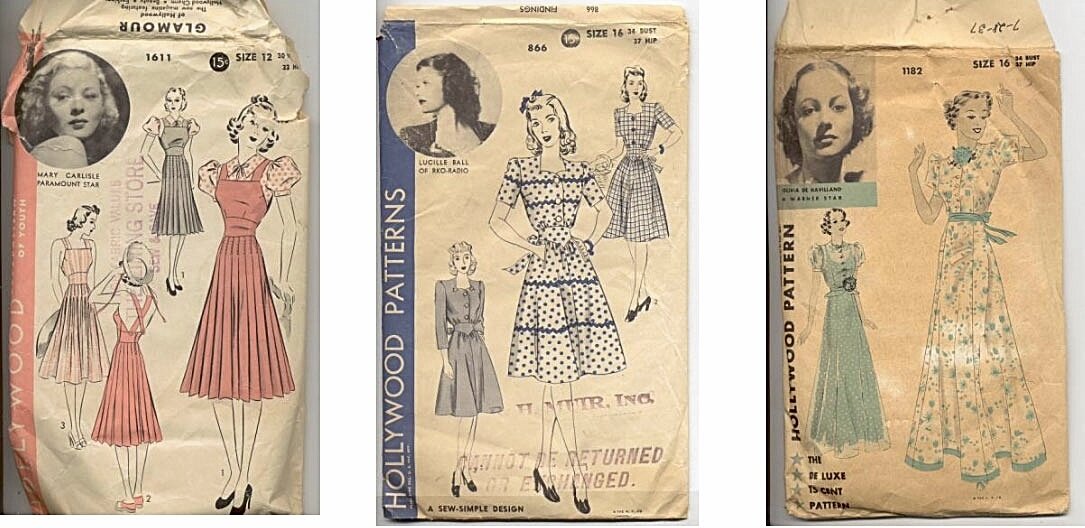This article was written a few years ago for a museum studies graduate school class. The wonderful thing about vintage fashion is that so much stays absolutely relevant—including longing to dress like a star.
The article refers to:
Emery, Joy. (2001). “Dress Like a Star: Hollywood and the Pattern Industry”. Dress, 28:1, 92-99, DOI: 10.1179/036121101805297761
Author Emery’s article notes that the movie industry flourished during the Great Depression of the 1930’s, when many industries were unable to survive the crippling economic downturn. That success is usually attributed to the escape (from the effects of the grim economy) that movies offered the moviegoer. The fantasies of lavish movie lifestyles buoyed the moviegoer who was sinking under the struggles during the Great Depression. Those fantasies could spillover into reality in the guise of ready-to-wear and, homemade replications of the extravagant fashions worn by the movie stars. In that way, the success of the movie industry was able to bolster both the moviegoer and related industries, such as that of the ready-to-wear and pattern industries.
Ready-to-wear manufacturers and the movie industry collaborated to promote clothing lines based upon fashions worn by the movie stars. Some of the manufacturers of ready-to-wear fashions opened stores specifically dedicated to Hollywood fashions. In advance of a movie’s release, they were frequently given a preview of the wardrobe, in order that they be prepared with similar garments when the movie opened.
As Emery noted: “Homemade garments capturing the élan presented in films offered the opportunity to dress like a star, in spite of hard times.” The effects of the Depression were felt by the pattern manufacturers, too. Established companies such as Butterick and Vogue were struggling. McCall’s “dropped their licenses with Paris couturiers to cut their costs.” Simplicity appeared in 1928 and offered dress patterns at half or even less than half the price of the other pattern manufacturers, thus applying even more economic pressure to the struggling companies.
Emery notes that in 1929 Elite Pattern Company “introduced an early instance of patterns based on frocks seen on the silver screen.” The company did not survive the 1929 crash, however, and ceased operation later that year. As the Depression worsened and increased the pressure on the pattern industry, the pattern companies turned to the profitable movie industry for inspiration. Conde Nast, owner of Vogue magazine and Vogue patterns, created a new and less expensive line of Hollywood Patterns.
The patterns were, as the manufacturer noted: “… inspired by the clothes of the smartest stars, not copied from them.” They were also produced for women’s, children’s, and men’s clothing. Many of the pattern envelopes, as seen above, featured a picture of the starlet, who was expected to participate in promotional activities related to tie-ins such as Hollywood Patterns.

Butterick followed suit (you should pardon the pun) with their Starred Patterns series, as did fan magazines, such as Silver Screen, which sold film-inspired patterns through mail order.
Hollywood Patterns ceased production in 1947, as the nation was caught up in the turmoil of World War II and the article summarizes:
Movie fashions provided a major marketing tool for the pattern companies. Marking its direct influence, Hollywood spawned a number of subsidiary pattern names, such as Butterick’s Starred Pattern, Silver Screen, Star, Screen Star, and Photoplay. Somewhat less obvious is the impact of Hollywood fashions on the regular styles offered by pattern companies. Popular themes, such as the Letty Lyton-inspired shoulder ruffles or Walter Plunkett’s barbecue dress for Scarlett O’Hara permeate the pattern catalogues in the 1930’s and early 1940’s. For Conde Nast’s enterprise, they provided an opportune resource with mass appeal. Hollywood Patterns and the other spin-offs were popular and promoted the fantasy of dressing like a star.
Written by: lkranieri